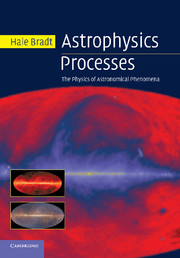Book contents
- Frontmatter
- Contents
- List of figures
- List of tables
- Preface
- Acknowledgments
- Also by the author
- 1 Kepler, Newton, and the mass function
- 2 Equilibrium in stars
- 3 Equations of state
- 4 Stellar structure and evolution
- 5 Thermal bremsstrahlung radiation
- 6 Blackbody radiation
- 7 Special theory of relativity in astronomy
- 8 Synchrotron radiation
- 9 Compton scattering
- 10 Hydrogen spin-flip radiation
- 11 Dispersion and Faraday rotation
- 12 Gravitational lensing
- Credits, further reading, and references
- Glossary
- Appendix: Units, symbols, and values
- Index
8 - Synchrotron radiation
Published online by Cambridge University Press: 05 June 2012
- Frontmatter
- Contents
- List of figures
- List of tables
- Preface
- Acknowledgments
- Also by the author
- 1 Kepler, Newton, and the mass function
- 2 Equilibrium in stars
- 3 Equations of state
- 4 Stellar structure and evolution
- 5 Thermal bremsstrahlung radiation
- 6 Blackbody radiation
- 7 Special theory of relativity in astronomy
- 8 Synchrotron radiation
- 9 Compton scattering
- 10 Hydrogen spin-flip radiation
- 11 Dispersion and Faraday rotation
- 12 Gravitational lensing
- Credits, further reading, and references
- Glossary
- Appendix: Units, symbols, and values
- Index
Summary
What we learn in this chapter
Intense light emanating from electrons circulating in an accelerator (synchrotron) was the first evidence that radiation from relativistic electrons can be much more intense than expected classically. A few years later, in 1954, light from the Crab nebula was found to be polarized, thus demonstrating that the nebula contains highly relativistic electrons spiraling around magnetic field lines. This radiation is now called synchrotron radiation or magnetic bremsstrahlung.
A relativistic electron circulating around magnetic field lines radiates primarily into a narrow beam in the forward direction owing to aberration, the so-called headlight effect (Chapter 7). The characteristic frequency of the detected radiation is simply the inverse of the time the beam takes to sweep over an observer. This frequency turns out to be about equal to the Lorentz factor squared times the cyclotron frequency; it thus increases as the electron energy squared.
The power radiated by a circulating electron is found from the classical Larmor radiation formula applied in an inertial frame of reference in which the electron is momentarily at rest. The power transformed back to the observer frame grows as the square of both the electron energy and the magnetic field. The electron energy divided by this power yields the characteristic lifetime of electrons at this energy. […]
Information
- Type
- Chapter
- Information
- Astrophysics ProcessesThe Physics of Astronomical Phenomena, pp. 290 - 328Publisher: Cambridge University PressPrint publication year: 2008
